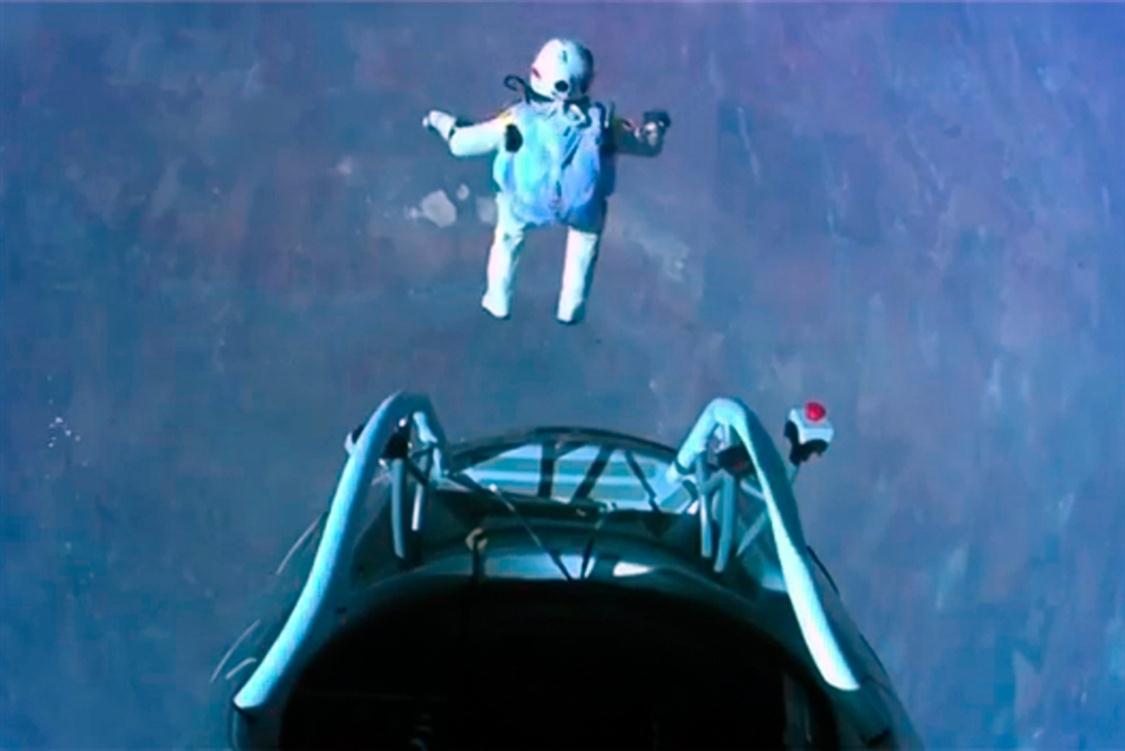The Keynote Speaker for the conference was Dr. Gardner Campbell. As you can see from his bio at http://www.educause.edu/members/w-gardner-campbell. He is quite the Renaissance Man.
He started his talk with this photo of the launch from the Stratosphere

http://msnbcmedia.msn.com/j/MSNBC/Components/Photo/_new/g-121014-cvr-felix-3p2.photoblog900.jpg
and these quotes.
“Academia is to knowledge what prostitution is to love; close enough on the surface but, to the nonsucker, not exactly the same thing.
“It may be learning, but it’s not academics.”
– A colleague’s response when the presenter first introduced him to the World Wide Web.
The presenter claims that despite academic resistance OER (Open Educational Resources) has won thanks to MOOCs, Coursera, Udacity, edX and Edupunks.
However,
“That is not it at all,
That is not what I meant, at all.
T.S Eliot. The Love Song of . Alfred Prufrock
These initiatives do not fit with the original vision of OER. We are in a double bind. We see the potential of open educational resources, but the actual implementation of it is not what this speaker originally envisioned.
For a better understanding of the issues surrounding OER, the speaker recommended The Children’s Machine: Rethinking School in the Age of the Computer by Seymour Papert and Steps to an Ecology of Mind by Gregory Bateson. Open is an attitude towards systems. He differentiated between Schoolers (i.e., those who school or are schooled) and Yearners (those with a strong desire for something more than schooling or academics). He also recommended To Repair the Ruins a series of essay on Milton as well as Who Am I by Pete Townshend for a better understand of the issues arouond this double bind.
We were presented with Bateson’s Hierarchy of Learning.
Learning Zero: “…is characterised by specificity of response, which – right or wrong – is not subject to correction.”
Learning 1:”…is change in specificity of response by correction of errors of choice within a set of alternatives. ” e.g.,Pavlov, habituation, adaptation.
Learning II: “…is change in the process of Learning I, e.g. a corrective change in the set of alternatives from which choice is made, or it is a change in how the sequence of experience is punctuated.“
Learning III:“…is change in the process of Learning II, e.g. a corrective change in the system of sets of alternatives from which choice is made.“
Learning IV: “…would be change in Learning III, but probably does not occur in any adult living organism on this earth.”
The hierarchy is discontinuous. Just as a longer B paper does not become an A paper. All communication has this characteristic — it can be magically modified by accompanying communication.”
Double bind may also be the way out.
Beyond access and cost: a primary benefit of open education insofar as it is not merely open but opening, This is the opportunity for networked transcontextualism — a planetary double-take.
BUT
Don’t fake the double take!
We were then given examples (places) where he found the double-take happening in a course.
The first example was his course, From Memex to YouTube: Cognition, Learning and the Internet
He created a variation of the Apgar test for class meetings.
Then there is the “dackolupatoni“ experiment.
He closed his presentation with quotes from two poems.
We shall not cease from exploration
And the end of all our exploring
Will be to arrive where we started
And know the place for the first time.
T.S. Eliot — “Little Gidding” (the last of his Four Quartets)
At a Window
Give me hunger,
O you gods that sit and give
The world its orders.
Give me hunger, pain and want,
Shut me out with shame and failure
From your doors of gold and fame,
Give me your shabbiest, weariest hunger!
But leave me a little love,
A voice to speak to me in the day end,
A hand to touch me in the dark room
Breaking the long loneliness.
In the dusk of day-shapes
Blurring the sunset,
One little wandering, western star
Thrust out from the changing shores of shadow.
Let me go to the window,
Watch there the day-shapes of dusk
And wait and know the coming
Of a little love.�
Carl Sandburg
The entire presentation is available online at http://bit.ly/Gardner-Keynote